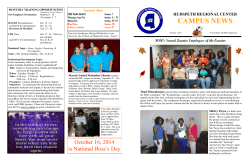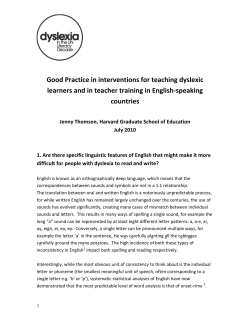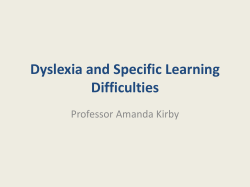
Dyslexia FREE Information for teachers and other professionals
Pl EE FR ke ta e on Information for teachers and other professionals se ea Dyslexia What is dyslexia? An introduction “Dyslexia is a learning difficulty that primarily affects the skills involved in accurate and fluent word reading and spelling.” Rose Review June 2009 The word dyslexia comes from the Greek, and means “difficulty with words”. Dyslexic people find it harder to remember what words sound like and what they look like, hence their difficulties in learning to read and spell. Teachers might notice a child has problems not just with reading, but also with writing, spelling, maths, memory, motor skills, organisation and maybe even selfesteem. Dyslexics can take longer than others to process words. They may listen and understand more slowly, or read and understand more slowly. Dyslexia is a difficult concept to understand as it occurs across the range of intellectual abilities. Information is processed by the dyslexic brain in a different way to the orderly sequenced way that many non-dyslexic people think, plan and solve problems. This often means that dyslexic people are more creative and can come up with very different solutions to problems. This can make them very successful in adult life, but maybe not so in school, where children are often expected to all learn in the same way. Dyslexia should not and need not be a barrier to achievement. People with dyslexia are just as talented, intelligent and capable as anyone else, and with the right kind of support they can do just as well across a wide range of professions. Famous dyslexics include Jamie Oliver, Tom Cruise, Sir Steve Redgrave, Sir Jackie Stewart and Sir Richard Branson. Albert Einstein and Thomas Edison were also believed to be dyslexic. “Barrington Stoke books are ideal for young people with dyslexia because they look good, like ‘real’ books, neither babyish nor a colour-stickered graded reader. The visual aspects have been considered with font size and type and background colour, and the illustrations are complementary rather than too intrusive and are appropriately placed in the text. These books really work.” Bernadette McLean, Principal, Helen Arkell Dyslexia Centre For more informa tion on dyslexia and useful links Dyslexia What to look out for All children have their strengths and weaknesses, and dyslexic children are no different. Not all children with dyslexia are affected by all these aspects, but you may notice: Poor spelling Poor working memory Mixing up sequences such as days of the week, months or the alphabet Confusing letters and words Difficulty in learning number bonds or doing mental arithmetic The child has to try hard and tires easily The child is better at ‘talking it’ than ‘writing it’ A discrepancy between how the child generally performs and how well he or she is doing with literacy skills The child may also be struggling in other ways. A few things to consider asking the parent: Was the child late in learning to speak? Is the child reluctant to go to school? Is homework something you all dread? Is there a family history of learning difficulties? Anecdotal evidence suggests that dyslexic children may have talents in: Non-verbal communication – so they may make friends easily Visual spatial skills – playing with Lego or computer games Creativity – stories, pictures, poems Games and sports Music, art and design Assessments An assessment will confirm whether the child is underperforming and give the parent some suggestions on what to do, possibly including some specialist tuition. A good assessment will help everyone understand how the child’s brain is working and what his or her strengths are as well as the difficulties. For more information on where to get assessments visit www.barringtonstoke.co.uk/dyslexia go to our website a t www.barringtonstoke.co.uk Creating a Dyslexia Friendly Classroom By Bernadette McLean, Principal, Helen Arkell Dyslexia Centre “The bonus of creating a dyslexia-friendly classroom is that it will facilitate learning for everyone in the school.” The Helen Arkell Dyslexia Centre estimates that 10 per cent of children are noticeably dyslexic, with about 4 per cent being severely dyslexic. Bernadette McLean offers some proven strategies for meeting their needs in mainstream classrooms. Speaking and listening The main difficulty that dyslexic children have is with listening to and processing the spoken word at speed. If teachers can slow down their speech and make sentence structures simpler, this will help all children’s understanding. Give plenty of time to practise listening. Teach children how to use visualisation and make pictures in their heads. Pictures are more easily remembered than lots of auditory words. Take pauses to give children thinking time. Setting appropriate tasks Dyslexics can take longer to name well-known objects, even up to higher education level and beyond. Slower word retrieval means they cannot offer speedy contributions in class, even when they know the answer. The stress affects their working memory. They have a far slimmer chance of ever reaching automatic retrieval of knowledge, which makes it hard to multi-task. Avoid setting rote-learning exercises for anything: times tables, scientific formulae, French vocabulary. The process of reading and memorising will take a dyslexic child much longer, so allow extra time for such activities. Rather than having low expectations of children who have difficulties reading and writing, give them opportunities to demonstrate their knowledge and understanding in other ways, for example through mind mapping, visual presentation or discussion. Homework Homework can be stressful for children with dyslexia because, whatever the subject, the homework often turns into English homework. Do not ask dyslexic children to copy For more informa tion on dyslexia and useful links down homework instructions. If you are not able to give all the class written instructions, ask someone else to do the copying for dyslexic children. If you give verbal instructions, check that they are being remembered. Set up a homework buddy system and give parents the buddy’s details, in case there is confusion over homework instructions. Spelling and punctuation It’s a good idea to mark separately for content and for spelling and punctuation. If there are a lot of mis-spellings, only mark high-frequency words and compile a personal checklist of the words the child most often gets wrong. Display highfrequency spellings on posters around the classroom, and when you introduce a new word write it on the whiteboard. In secondary school, where time is not spent learning spellings by looking at the structure of words, it is particularly important for students to have a handy reminder of words they find difficult. Reading Don’t ask children to read aloud unless they want to. Reading silently may work better. To read aloud successfully they have to link the sound and the look of the word, which can be effortful. Paired reading has been around for a long time and is as useful as ever. The benefits of reading at home with parents are enormous. Little and often is the key to success. Classroom layout/resources Children with dyslexia should sit within the peripheral vision of the teacher so they can pick up on non-verbal communication. Clearly mark resources with pictures as well as words, and display a pictorial timetable. Have an alphabet strip on each desk and a number square on each table to cut down on memory work. Display the topic, keywords, date and day on the whiteboard. Display an analogue and digital clock side by side for reinforcement. The digital clock is easier to read but does not help the child understand time. go to our website a t www.barringtonstoke.co.uk Teaching tips Check that the pupil is secure with their knowledge of phonics Re-visit any gaps Allow plenty of time for practicing phonic skills Practise memory skills Use a multi-sensory approach When practising spellings, try the ‘Look, say, copy, cover, write and check’ method Remember that pupils with dyslexia may tire quickly and be careful not to overload with homework For older pupils, allow alternative methods of recording their work Keep self-esteem healthy by building on areas of strength and praising effort A visual timetable which uses symbols as well as words can help a dyslexic child confidently negotiate the school day From A Whistle-stop Tour of Special Educational Needs by Clare Welsh and Rosie Williams (Barrington Stoke) “This year we are lucky to be working closely with Barrington Stoke – the market leader for reluctant readers. Like us, they believe in the importance of reading, and by working together we hope to enable more children to reach their full potential. Barrington Stoke publish accessible, enjoyable and unpatronising short books for children who are dyslexic, struggling to read, or simply reluctant to sit down with a book. They have some of the best children’s authors writing for them and their books have proved popular among all our centres.” Dyslexia Action For more informa tion on dyslexia and useful links How to choose books that are dyslexia-friendly © Patience Thomson 2006 “My daughter is 10 and a half years old and has dyslexia… We discovered Barrington Stoke about a year ago. For the first time ever she is enthusiastic about reading and actually asks me, “Can I read another chapter?” This from the child who used to cry whilst trying to read. So, many thanks for providing such wonderful, appropriate books for children like my daughter.” Parent First impressions The books should look attractive and individual but not too different. The covers should be stylish and in no way indicate that they are aimed at less able readers. Gripping stories Don’t go for books that are technically easy to read if the stories are babyish and dull. Choose authors who know how to write an exciting story and grab the child’s attention from the first page. Language Watch out for oddly spelled, unusual or difficult words. If there are too many it will slow up the reading process. For example, ‘fast’ is easier than ‘quickly’, ‘wizard’ than ‘magician’ and ‘most of the time’ than ‘usually’. Words like ‘neighbour’, ‘unique’, ‘echo’ and ‘anxious’ will be real stumbling blocks. Beware also of vocabulary that is dumbed down or over-simplified. Style – keep it simple Look for a simple and direct style. There should be nothing to hold up the flow of the story. Barrington Stoke books avoid long, complicated sentence structures full of sub-clauses (for example: ‘Feeling lonely, he sat there miserably, under the tree, in the rain, until it got dark.’) Keep it short! Children will get such a confidence boost if they can get to the end of a book. go to our website a t www.barringtonstoke.co.uk The Barrington Stoke Range Series Go! NEW Solo Reading Age Interest Age Illustrations 6 11+ Yes 6.5 10 - 14 Yes 4u2read 7 9 - 12 Yes gr8reads 12+ 7 12+ Yes Plays NEW 7 12+ No Novels 9 - 12 8 9 - 12 Yes Reloaded (myths and retellings) 8 10 - 14 Yes FYI (fiction with facts) 8 10 - 14 Yes Reality Check (true stories) 8 10 - 14 Yes Novels 12+ 8 12+ No Graphic Novels 8 12+ Yes Most Wanted 8 18+ No Further information For more detail go to www.barringtonstoke.co.uk/dyslexia All these websites offer a wealth of information on training and assessments and on dyslexia for teachers and other professionals and for parents and carers. www.arkellcentre.org.uk www.dyslexia-parent.com www.bdadyslexia.org.uk www.dyslexiascotland.org.uk www.dyslexiaaction.org.uk www.patoss-dyslexia.org www.dyslexia.bangor.ac.uk www.thedyslexia-spldtrust.org.uk “Dyslexia’s like when the wind blows a television aerial round and the screen goes all fuzzy. My brain is the TV.” 18 Walker Street, Edinburgh EH3 7LP T: 0131 225 4113 • F: 0131 225 4140 E: info@barringtonstoke.co.uk www.barringtonstoke.co.uk © Bernadette McLean and Barrington Stoke 2009
© Copyright 2025





















